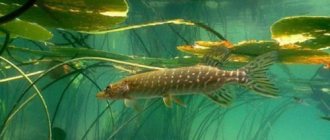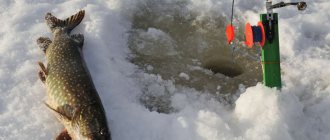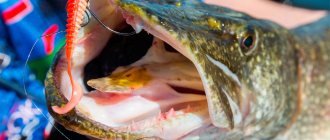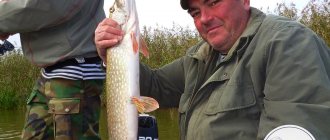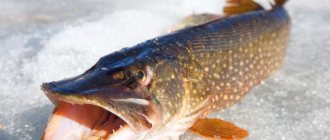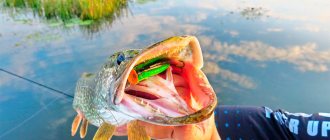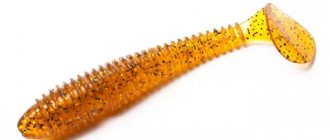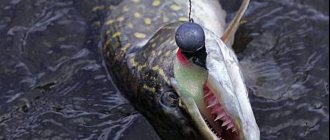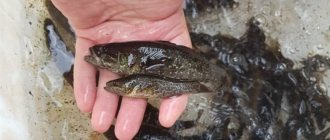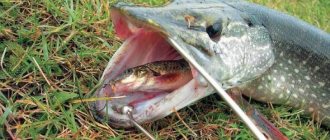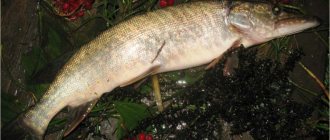More and more often, anglers argue about how useful bite activators are. Moreover, the most serious discussions are related to the question of whether it makes sense to use attractants on pike? Will this improve her bite or not? Some say that such substances are ineffective when catching predators and are more like a placebo. While some fishing enthusiasts call for regular use of bite activators to catch pike. Whose side is the truth on? Let's try to figure it out.
When fishing for pike, you can try using various bite activators
Pike's sense of smell and the effectiveness of attractants
Let's start with the question of whether this fish perceives odors, because it is believed that aromatic substances are of no use when fishing for pike. Is it so? It’s definitely not easy to answer. First, you need to understand whether the pike generally uses smell during feeding or focuses on other senses? The following information should help with this:
- The toothy predator really barely distinguishes odors. Her vision works much better. Pike can see bait even at a decent distance - up to 10-12 m. In clear water - even further. Therefore, vision is considered its main “assistant” in searching for prey.
- In the process of life, almost all fish use a sensory organ called the lateral line. With its help, they are able to detect vibrations and vibrations in water. For pike, the lateral line is the main assistant in the search for food.
- Most fishermen and ichthyologists believe that pike do not use their sense of smell at all when hunting and feeding. This means that it is impossible to attract her with any smells. Is it so? We would not categorically state that pike does not perceive aromas at all. After all, why then do experienced fishermen make cuts on live bait? It’s right to bleed such bait. Thus, a trail of odor attractive to pike begins to emanate from the fish. She responds to him.
Attractants for pike are less effective than for other fish, due to the weak sense of smell in pikes
Let's summarize what has been said. Pike mainly feed and search for food using sensory organs such as vision and the lateral line. She may also use her hearing, while she rarely uses her sense of smell.
But sometimes the smell of the bait affects whether the pike attacks it or not. This means that flavorings can (slightly!) improve the bite of this predatory fish.
It turns out that the sense of smell, to put it mildly, is not the strong point of the “toothy”. Therefore, it is wrong to expect that aromatic substances will seriously increase the attractiveness of the bait. However, when you use different wobblers, twisters, spinners and spend hours fishing in all sorts of places on a pond, but there are still no bites, then you seriously think about why not try an attractant. However, sometimes fishing flavor really helps. Coincidence? Accident? Hardly.
So which smell does pike bite better at?
Remember - odors that disgust humans are appetizing and pleasant. Pike is no exception.
Some attractants that are sold in fishing stores are so unpleasant that even applying them to the bait makes you want to finish the process as soon as possible.
The pike happily goes for such aromas, brushing aside all doubts about the edibility of the future dinner.
The most attractive odors for pike include:
- crayfish;
- herring;
- shrimps;
- anise;
- garlic.
Please note that if you prepare the attractant at home, you should add salt to the resulting “tincture”. It enhances the smell for the predator and increases its “taste” qualities.
The recipe is the same for all types of flavors:
- the source material is crushed;
- the resulting slurry is mixed in water;
- It remains to infuse for a day.
Actually, that's all. All that remains is to treat the bait with the resulting liquid. It will also not be superfluous to attach a piece of the original material to the hook of the spoon - this will increase the attractiveness of the bait.
Separate conversation - blood. The ideal option for fishermen is to squeeze the offal large predatory fish, such as pike perch or other pike.
After a thorough squeeze, the product can be directly without treatment and thrown into the water. Salt, by the way, won’t hurt either - it needs to be applied on top of the squeeze.
Important. When fishing for pike with live bait, the bait should be cut in several places. The blood released and the entrails falling out increase the level of odor in the pond, which means that the pike will be more interested in such a meal.
Pike is a fisherman's dream. The distribution of odors in the reservoir plays a significant role in its capture . specialized stores and homemade products may be suitable for this If the scent is chosen correctly, then the pike will not have the strength to resist it, and very soon it will end up in your landing net!
When is the best time to use attractants for pike?
It seems that bite activators can and should be used in some cases. Not much, but still they can improve the feeding activity of pike. However, you should not perceive attractants as a panacea for all ills. Even the manufacturers of such products themselves say that the task of bite activators is only to force an indecisive fish to grab the bait, as well as to attract its attention.
To successfully catch pike, it is important to choose the right bait.
The best way to try to find the “key” to successful pike fishing is by experimenting with:
- color and type of bait;
- wiring style;
- duration of pauses during rewinding;
- casting points, etc.
If all else fails, you can also use a bite activator. After all, many fishermen have repeatedly noticed that pike pursue baits treated with attractants more readily. So she can smell? Probably yes. But not in those moments when he is hiding in shelters, lying in wait for his prey, but during active hunting.
If the pike is hiding in a snag, then it will rely only on its vision or lateral line. After all, sitting in ambush and waiting for prey, the predator does not care at all about smells.
A bait treated with an attractant can increase the chance of catching a pike
Therefore, attractants are effective when pike moves around a reservoir, looking for food or feeding places. In this case, predatory fish are able to sense odors. Especially when it chases the bait and gets close to it. It turns out that it is most rational to use flavorings during the so-called “exits” (moments of active biting).
Naturally, many fishermen do not do this. After all, there are already bites - why use attractants as well. In vain. Aromatic substances can keep pike in the fishing spot for a longer time.
So we recommend you several options for using bite activators:
- Treat your bait regularly throughout your fishing trip. Probably, a pike holed up in a shelter will not react in any way, but an actively moving predator may grab a wobbler or “silicone” treated with a flavoring agent.
- Connect attractants during bites and “exits”. This way you can extend the feeding time of the pike. With their help, it will be possible to keep it in the place of fishing longer.
Using a bite activator can make pike react more actively to the bait - Are there many unsuccessful bites? And do you feel that the pike is “hollowing” or chasing the bait, but then abandons it? Most likely, she understands that in front of her is not a live fish, but an artificial one. In this case, the use of an attractant will help - the predator will feel a bright taste and smell. As a result, it will begin to attack the bait more actively and aggressively.
Popular attractants for pike fishing, operating principle
Pike, as one of the most common representatives of predatory fish, in its hunting is more focused on vision and the lateral line. This is determined by nature, which does not give it much time to attack live bait or other bait. The two senses work faster than the sense of smell, but it cannot be discounted. It is not for nothing that experienced amateur fishermen make small cuts on live bait - its blood helps provoke the pike in those moments when the predator is not active.
This feature was taken into account by manufacturers of pike attractants, producing them in the form of:
- gels;
- sprays;
- oils;
- pasta.
The method of using them is simple - you need to apply them to the bait before casting. Sometimes it makes sense to soak it in an attractant (this is what you do, for example, with foam fish and silicone baits). When preparing in advance for going out to the reservoir, you can use this method. For use during fishing itself, a spray or gel (cream-lubricant) is more suitable due to its ease of use.
The bait material absorbs a certain amount of attractant, which releases when it gets into the water, especially at the beginning of the retrieve. This smell is stimulating, encouraging the fish to take active action. Fishing always serves as an open field for experimentation, since it is unknown what can provoke a predator to bite at the current moment. In combination with such factors as changing the type of wiring, the color of the bait, the use of fishing “chemistry” can give a good result during the non-biting period.
Let's look at the two most popular pike attractants.
Mega Strike Pike
Widespread advertising of the latest “miracle bait” always alarms experienced fishermen. They know well that the sense of smell is not a strong quality of pike and the smell of the bait will not play a decisive role in the execution of the vole. But! Research conducted by the manufacturing company has shown that the “highlight” that increases the number of bites realized is the fish’s enthusiasm when attacking the bait.
The pike, having sensed a pleasant smell for it, will more violently grab the spinner (twister, wobbler, etc.). This will give the spinner a few extra seconds, enough to react to the first blow, which has well swallowed the bait of the fish. Fewer appointments means less disappointment.
Mega strike of the Pike series (translated from English as pike) is available in the form of a gel. Apply directly to the bait before casting. This attractant is ideal for pike fishing, as it is supplied with a sufficient amount of amino acids and natural components. The manufacturer, of course, does not disclose the full composition of the mixture. Mega Strike Pike has a large number of positive reviews from spinners, many of whom are pleased with the fairly strong smell of the product and its performance. But there are those who consider its action to be diametrically opposite. Price: 580-600 rubles for 57 g. tube.
Double strike "Pike"
The “Double Impact” attractant is applied according to the same principle - a lubricating gel is spread on the surface of the bait. Gradually dissolving in water, it attracts a nearby predator. After it approaches the bait, it forces it to cling harder to the attacked spoon, “rubber” or wobbler. Price: 150-200 rubles per 60 ml.
Opinions and reviews of anglers regarding this pike attractant, as in the case of Mega Strike, are divided. Some consider it a marketing ploy, others note the confident reaction of predatory fish. There is no clear answer to the questions that arise.
What to pay attention to
When fishing for pike, and just before you buy, you should pay attention to the composition of the attractant: pike bite better on plant components: amino acids, herbal and algae extracts. Chemical or strong synthetic odors will only scare away the fish. Being a very fastidious predator, pike does not react well to odors, but it smells blood well. Therefore, it is recommended to use this particular smell, as well as make cuts on the bait fish (in case of fishing with live bait).
For pikes, the second most preferred smell after blood is the smell of crayfish. Next on the list are anise, garlic, herring. Pike also reacts to salt, especially during the molting period, since salt contains substances necessary for its body.
Options for attractants for pike
The modern market offers many different types of flavorings to improve the bite. Most of these products are intended for catching peaceful fish. Therefore, attractants are mainly used by floaters, bottom fish, feeders, etc.
Although there are also many types of predator bite activators. Mainly:
- gels;
- sprays;
- pastes;
- powders;
- oils
Pike attractants can have different consistencies
They are quite easy to use. The bait itself should be processed. The attractant forms a special film on the wobbler, spinner, twister, etc. It is precisely this that becomes the source of the smell attractive to fish. At the same time, some baits are even capable of absorbing flavorings. For example, foam fish.
By the way, a high-quality attractant for pike is designed not only to attract its attention. The purpose of such a substance is to ensure that the predator does not immediately throw the bait, but holds it in its mouth for as long as possible. Even some tenths of a second are important. After all, this time may not be enough to hook the prey. Therefore, almost any pike attractant has an attractive taste, which confuses the fish, preventing it from immediately realizing that it is just bait.
Attractants for predatory fish species
Today it is no secret to any fisherman that attractants are an excellent addition to fishing for any peaceful fish. For reference, an attractant is a natural or synthetic substance created to attract an animal (in our case, fish). Attractants have also proven themselves well when fishing for sea fish at Russian resorts. In the Blue Wave sanatorium Gelendzhik photo-engineering photos from fishing can be viewed in the gallery. Holidays in Gelendzhik attracts the majority of Russian holidaymakers not only with comfort and service, but also with the most affordable prices. And the fishing here is simply excellent. Are there any attractants for predatory fish? Will the same product work on zander and pike? Is this bait generally good for predatory fish?
We did not say that natural aromas will attract pike. It could be the smell of fresh blood. That’s why experienced fishermen cut the fish when catching pike with live bait?
Remember that during the warmer months, fish prefer sweet, fruity smells. In cold weather, spicy aromas and odors of animal origin have a great effect - canned fish, fish oil, dried blood, bird offal, food for aquarium fish, crushed worms or bloodworms.
comments powered by HyperComments
Features of using attractants for pike
Not everyone knows how to use a bite activator correctly when catching predatory fish. Therefore, we recommend that you consider the following:
- It is necessary to select attractants based on what kind of food is the main food of the predator at that time on a particular lake or river. For example, it could be fish, various amphibians, or some shellfish. Accordingly, the taste and smell of such a substance should remind the pike of its usual diet.
- The predator will not be interested in artificial smells. Choose attractants with natural flavors - herring, shrimp, crayfish, etc.
When using silicone twisters, they should be prepared before using the attractant.
- Every half hour you need to “renew” the bait by applying a fresh portion of the substance. The average duration of action of the bite activator is 20-30 minutes. This time varies depending on the strength of the current, the composition of the water, its temperature, the number of hooks and other factors.
- You cannot mix different bite activators on one bait. It may turn out that the “synthesized” smell will cause hostility in the pike.
- Activators in the form of a gel or paste are applied not in dots, but in grooves or lines along the entire body of the bait. Thus, the likelihood increases that when attacking, the pike will be able to “taste” the flavor and feel it.
- It is better to treat some baits with attractants in advance. For example, silicone twisters, vibrating tails, worms, etc. Just then store them in airtight packaging. At the same time, we must not forget that “silicone” is often treated with factory lubricant, which does not retain odors. Such baits must first be cleaned, washed and dried. After which you can apply attractants to them.
- It is recommended to start with the least attractive or less concentrated odors. Gradually, you need to introduce more “strong” flavors. This will increase your chance of a good bite.
Only one attractant should be used for one bait
We have listed the main nuances of using attractants for pike fishing. It remains to focus your attention on just one more point. When there is a lot of small debris floating in a reservoir (suspension, grass, turbidity, etc.), or vegetation is blooming or rotting, then attractants will not have any effect. Why? Let's highlight several reasons:
- Flavorings are easily interrupted by other odors.
- In such dirty water, the amount of oxygen decreases, and the fish do not respond to them.
- The pike's behavior is changing. She spends her time in shelters, and feeds only on what floats practically in front of her nose.
Use of salt
Often, first-class attractants are supplemented with salt. The low temperature of the liquid does not prevent the spread of odors. Which is why salt very often acts as a food stimulant.
Which scent should you choose?
People and animals have very different tastes for different odors. What you certainly like will arouse hostility in the fish. It’s always a good idea to have a set of lubricants (1 bait – 1 attractant, mixing lubricants on baits is not recommended). It is advisable to start fishing with the most unpleasant odors. This increases your chance of a good catch. Soiled baits should be kept separately in sealed packaging.
The principle of lubrication of spinning baits
Through selection, you have a chance to choose your perfect option for any body of water. Lubrication should be done in advance (the bait is stored in sealed packaging). New silicone baits do not retain the attractant for catching predators for a long time due to the presence of factory lubricant. Before lubricating them, they should be washed and dried (it is better to use unscented detergents). There is an option to inject the substance inside using a syringe (especially foam baits).
DIY pike attractant
If you started hunting for pike, but the required attractant was not at hand, you can try to make it yourself. The main quality for a homemade attractant, in addition to its smell, is resistance to washing off. Vaseline performs this function. Also, almost all predatory fish react positively to salt. Therefore, the first thing we will need is Vaseline and salt. Just as mentioned above, blood is needed to lure pike. It can be obtained by cutting into existing caught fish. You will have to use fishmeal to bind it together.
Bottom line: in order to make bait for pike with your own hands, you need to mix Vaseline, about 40-50 grams, a couple of tablespoons of fish meal, fish blood and a little salt. Mix it all, achieving a homogeneous mass, preferably leave for 15-20 minutes.
